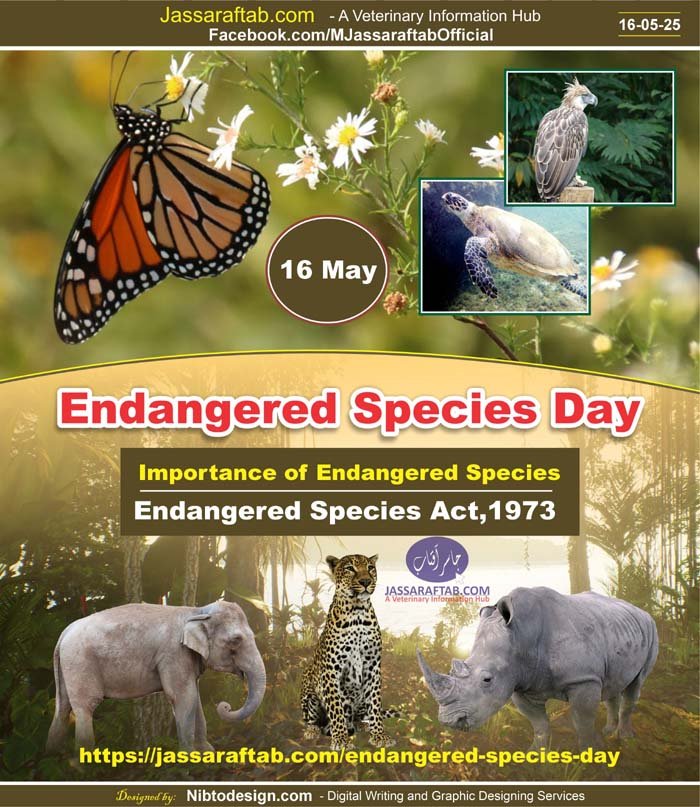Endangered Species Day | History of Endangered Species Day| Endangered Species Act, 1973
Every year, on the third Friday of May, the world observes Endangered Species Day. This day highlights the urgent need to protect plants and animals at risk of extinction. It doesn’t just honor the species we’ve lost—it serves as a powerful reminder to take action for those we can still save.
Currently, the IUCN Red List of Threatened Species includes more than 16,000 species of plants, animals, fungi, and algae listed as endangered. This growing number underscores the critical need for global conservation efforts.
پینگولن کا عالمی دن ، ہسٹری-خصوصیات اور دیگر معلومات
History of Endangered Species day
Endangered species day was created and founded by David Robinson and the Endangered Species Coalition in 2006. This day raise awareness about the growing threats to biodiversity. Notably, the day coincides with the anniversary of the Endangered Species Act (ESA) of 1973. This law was designed to protect and conserve species at risk of extinction.
However, it is considered one of the most powerful and successful conservation laws in the world. Since its inception, Endangered Species Day has evolved into a global movement, supported by influential organizations such as the National Wildlife Federation and the International Union for Conservation of Nature (IUCN).
Moreover, through educational campaigns, community events, and social media outreach, this day continues to inspire people around the world to protect endangered species and their habitats.
What is Endangered Species Act (ESA) 1973?
The Endangered Species Act (ESA) was signed into law by President Richard Nixon on December 28, 1973. The ESA aims to prevent extinction and restore species populations to levels where they no longer need legal protection. The U.S. Supreme Court has called it “the most comprehensive legislation for the preservation of endangered species enacted by any nation.”
The main purpose of the law is to protect and recover imperiled species. To achieve this, it classifies species as either threatened or endangered. Moreover, it requires federal agencies to actively contribute to the conservation of these listed species. In addition, the law safeguards them from harm, exploitation, and extinction, ensuring their survival for future generations.
The U.S. Fish and Wildlife Service (FWS) and the National Marine Fisheries Service (NMFS) jointly administer the Act. It also supports the international agreement CITES (Convention on International Trade in Endangered Species of Wild Fauna and Flora), which regulates global wildlife trade.
Importance of Endangered Species Day
Endangered species play a vital role in maintaining ecological balance, and their protection directly supports the health of entire ecosystems. First, each species contributes to the food chain, pollination, seed dispersal, or pest control, which keeps natural systems functioning smoothly. Furthermore, many endangered species hold scientific, medical, or agricultural value that benefits human well-being.
In addition, conserving these species helps preserve biodiversity, which strengthens ecosystems against climate change and environmental disruptions. Most importantly, by protecting endangered species, we also protect the natural habitats they depend on—benefiting countless other forms of life in the process.
Endangered Species
There are some notable Threatened species and critically endangered species, according to the International Union for Conservation of Nature (IUCN).
Mammals
Threatened species of mammals includes:
1. Asian Elephant
2. Amur Leopard
3. Snow Leopard
4. Black Rhino
5. Javan Rhino
6. Mountain Gorilla
7. Indus River Dolphin (Pakistan)
8. Red Panda
9. Saola (Asian Unicorn)
10. Pangolin (all 8 species are endangered or critically endangered)
Birds
1. Slender-billed Vulture (South Asia)
2. California Condor
3. Forest Owlet (India)
4. Philippine Eagle
5. Kakapo (New Zealand flightless parrot)
Reptiles and Amphibians
1. Hawksbill Sea Turtle
2. Leatherback Sea Turtle
3. Axolotl (Mexican salamander)
4. Fijian Banded Iguana
Marine Life
1. Vaquita (rarest marine mammal, Gulf of California)
2. Bluefin Tuna
3. Chinese Sturgeon
4. Giant Freshwater Stingray
5. Blue Whale
6. North Atlantic Right Whale
7. Hawksbill Sea Turtle
8. Green Sea Turtle
Plants
1. Western Prairie Fringed Orchid
2. Attenborough’s Pitcher Plant
3. Hawaii Chaff Flower
Insects
1. Monarch Butterfly (migratory populations)
2. Lord Howe Island Stick Insect








